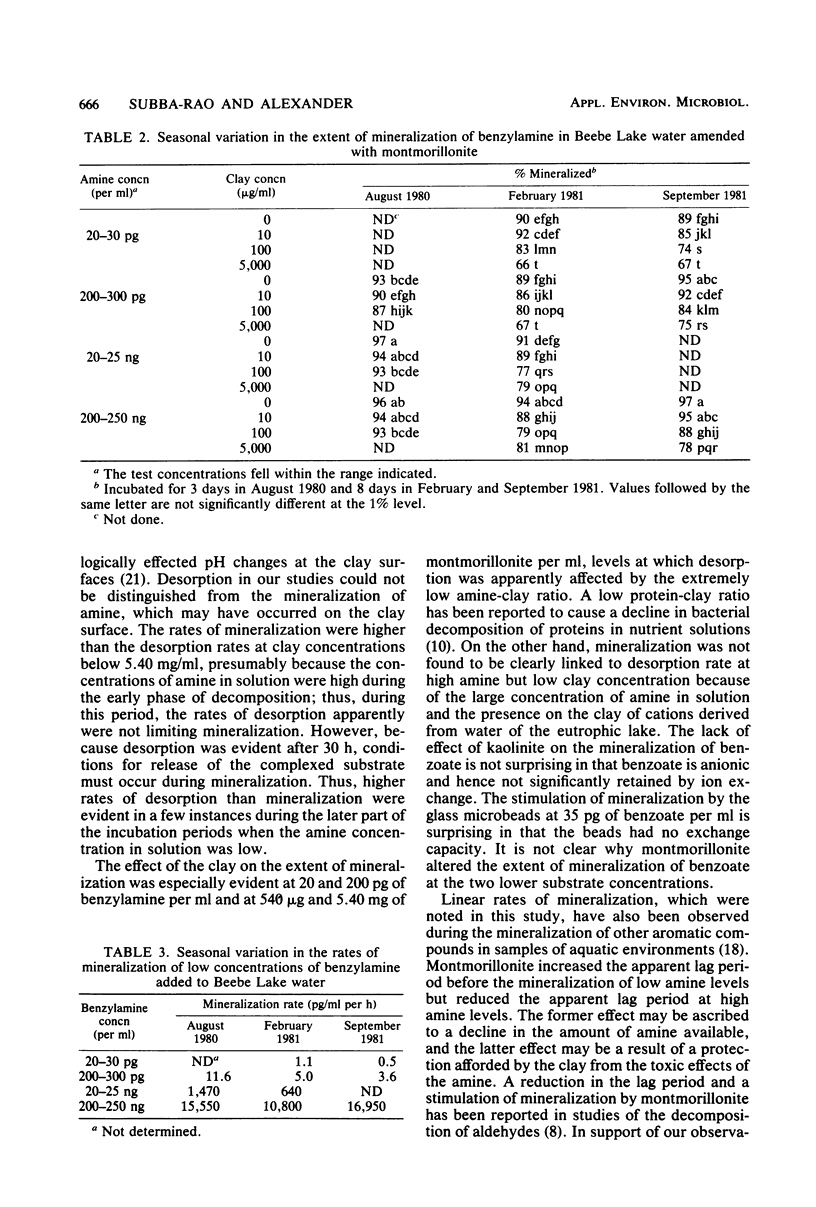Abstract
Montmorillonite-benzylamine complexes were formed immediately upon addition of 20 pg to 20 μg of amine per ml of suspensions containing the clay. The extent of amine sorbed was a linear function of equilibrium amine concentration in lake water. Increases in the clay concentration decreased the percentage of the organic compound that was mineralized at amine levels of 20 pg to 200 ng, but not at 20 μg/ml. A larger percentage of the chemical was released from the complex during mineralization in the presence of high clay concentrations than in the presence of low clay concentrations. The rates of desorption and mineralization increased linearly with benzylamine levels up to 200 ng/ml. Montmorillonite did not enhance mineralization rates at amine levels of 200 ng/ml or lower, but it was stimulatory at 20 μg/ml. Except at high amine and clay concentrations, mineralization was more rapid than desorption during the early periods of decomposition when the amine concentration in solution was relatively high. However, relative to the microbial demand, desorption was more rapid during later periods of decomposition when the amine level in solution was very low. Mineralization of benzoate was not usually affected by montmorillonite, kaolinite, or glass beads. More than 90% of the carbon from benzylamine and benzoate was often mineralized when the substrate concentration was 250 ng/ml or less. After incubation of the chemical in lake water, none of the radioactivity from benzylamine was in the particulate fraction containing natural sediment and microbial cells. The data indicate that clay may have a significant effect on the microbial decomposition of low concentrations of certain organic compounds.
Full text
PDF









Selected References
These references are in PubMed. This may not be the complete list of references from this article.
- Boethling R. S., Alexander M. Effect of concentration of organic chemicals on their biodegradation by natural microbial communities. Appl Environ Microbiol. 1979 Jun;37(6):1211–1216. doi: 10.1128/aem.37.6.1211-1216.1979. [DOI] [PMC free article] [PubMed] [Google Scholar]
- Nováková J. Effect of increasing concentrations of clays on the decomposition of glucose. I. Effect of bentonite. Zentralbl Bakteriol Parasitenkd Infektionskr Hyg. 1972;127(4):359–366. [PubMed] [Google Scholar]
- Rubin H. E., Subba-Rao R. V., Alexander M. Rates of mineralization of trace concentrations of aromatic compounds in lake water and sewage samples. Appl Environ Microbiol. 1982 May;43(5):1133–1138. doi: 10.1128/aem.43.5.1133-1138.1982. [DOI] [PMC free article] [PubMed] [Google Scholar]
- Stotzky G., Dawson J. E., Martin R. T., Ter Kuile C. H. Soil Mineralogy as Factor in Spread of Fusarium Wilt of Banana. Science. 1961 May 12;133(3463):1483–1485. doi: 10.1126/science.133.3463.1483. [DOI] [PubMed] [Google Scholar]
- Stotzky G., Rem L. T. Influence of clay minerals on microorganisms. I. Montmorillonite and kaolinite on bacteria. Can J Microbiol. 1966 Jun;12(3):547–563. doi: 10.1139/m66-078. [DOI] [PubMed] [Google Scholar]
- Subba-Rao R. V., Rubin H. E., Alexander M. Kinetics and extent of mineralization of organic chemicals at trace levels in freshwater and sewage. Appl Environ Microbiol. 1982 May;43(5):1139–1150. doi: 10.1128/aem.43.5.1139-1150.1982. [DOI] [PMC free article] [PubMed] [Google Scholar]


